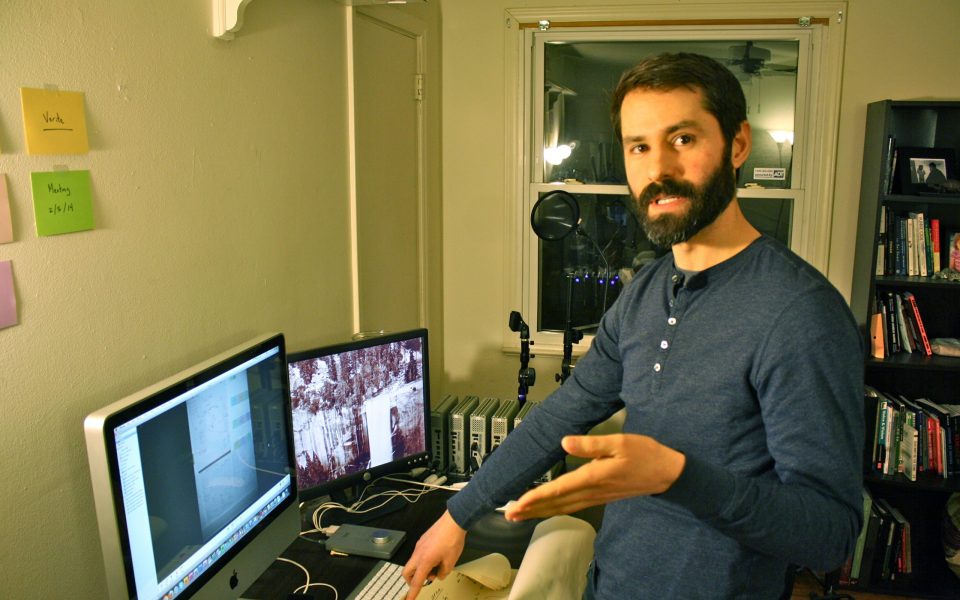by Eric Ginsburg
When Rick Dillwood started film school at UNCG in 2008, he wanted to make a Western.
It would be a modern-day adaptation on the genre, playing on the recurring theme of cowboys and their almost otherworldly relationship to the land. But based on what he saw happening to ranches near his California hometown, the film would’ve been about cowboys who sell their land for real-estate development and cookie-cutter condos.
Around the same time, Dillwood’s neighbors asked him if he’d be willing to be their sperm donor. The lesbian couple was looking for a known donor who would play at least some role in their future children’s lives, and after Dillwood agreed, he joked that it would make a great documentary project.
He didn’t really take the idea seriously — the idea didn’t seem to count, what with him being such a central part of the story — until a professor encouraged him to go for it. After being exposed to Ross McElwee’s work that fuses personal narrative with more traditional documentary style, Dillwood started figuring out how to tell the story.
“How to Make a Heartbeat,” the short he developed during that first year of film school, captured intimate moments and provided a narrative of lesbian families that was — and is — generally lacking in the mainstream. Dillwood shot it himself, providing a thematic fit with the closeness of the story that he describes as a “weird balance of relatable and hyperpersonal.”
He was blown away when his professor suggested he submit it to film festivals, so imagine Dillwood’s reaction when the short was accepted to festivals in Austin and San Francisco, and some international ones, too.
He still thinks about that Western all the time, but now his camera swings in a different direction, towards documentaries about queerness. Part of that is a natural progression as he makes connections with people who are drawn to his existing work, but a trip to the Austin festival and participating in a Q&A after the screening also acted as a pivot point.
“Seeing how meaningful it was to people there totally changed my perspective on the kinds of stories I wanted to tell,” Dillwood said.
In his final year of film school, Dillwood expanded the short into a 40-minute piece. After graduating and initiating a successful Kickstarter to further develop and finalize the film, Dillwood realized he needed to pull apart his existing work rather than simply tacking more edited footage onto the end.
Filming began in February 2009, continuing in spurts over the years and culminating in the feature film Between Friends and Family in 2012.
Yet despite the success of his initial short, the film struggled. This time the festivals passed on Dillwood’s work, and it chafed him.
“It’s as good as I can possibly make it,” Dillwood said.
The anticlimactic culmination of years of work didn’t fizzle entirely — an organization called Films Media Group reached out to add Between Friends & Family to its catalog of films available to university libraries, and Dillwood is still making shorts.
The wall in a home office area above dual computer monitors storyboards dates and events for a short film he is working on as part of a newer project called “Keeping It Queer.” Partnering with Carrie Hart, an associate producer for Between Friends & Family, Dillwood has worked incrementally but steadily on short web episodes about queer organizations in the area. Keeping It Queer is working on its ninth episode and the pair is making plans to turn one about queer-oriented summer rock camp QORDS into a 30-minute doc.
Though he embraced working alone on his films during grad school, Dillwood is enjoying working with partners.
“I feel like I’m getting away with something because it’s so much easier,” he said.
Join the First Amendment Society, a membership that goes directly to funding TCB‘s newsroom.
We believe that reporting can save the world.
The TCB First Amendment Society recognizes the vital role of a free, unfettered press with a bundling of local experiences designed to build community, and unique engagements with our newsroom that will help you understand, and shape, local journalism’s critical role in uplifting the people in our cities.
All revenue goes directly into the newsroom as reporters’ salaries and freelance commissions.


Leave a Reply